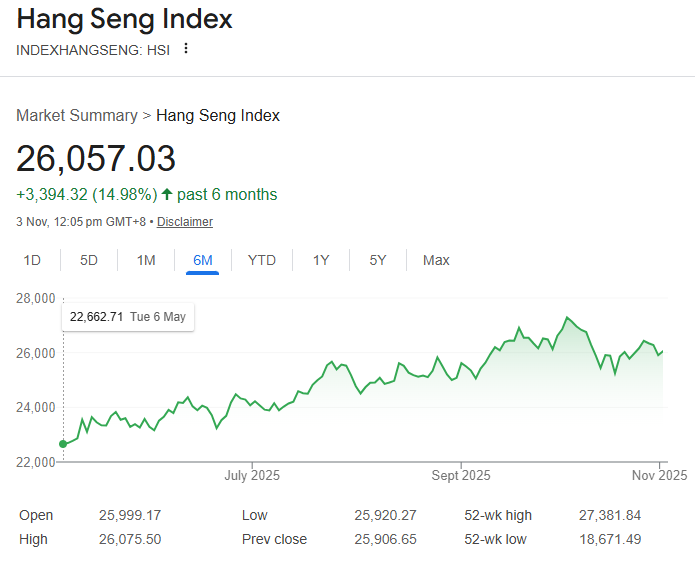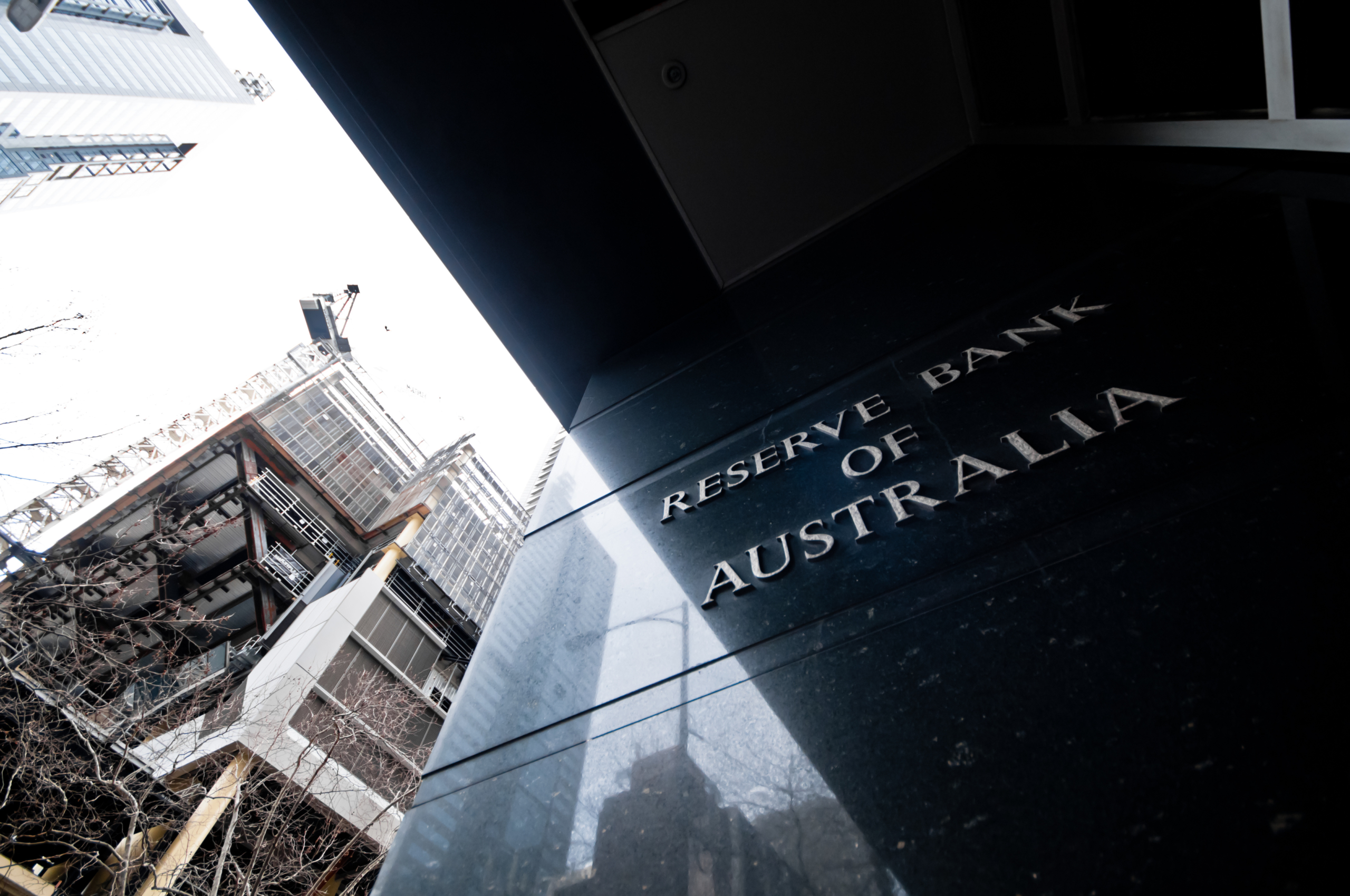市场资讯及洞察
%20(1).jpg)
震荡中的信号,港股能否迎来真正的底部?
10月,恒生指数延续回调格局,全月累计下跌948点,月初触及27,381点高位后快速回落至25,145点,跌幅达到61.8%的黄金比率水平,随后虽反弹至26,588点,但未能持续突破,显示短期受均线压制,向上动力有限。内地9月制造业PMI创半年低位且低于预期,加上全球宏观因素如美元走强、通胀压力持续,使恒指多次受挫,市场情绪谨慎。

进入11月,恒指夜期先行反弹69点,显示短期市场情绪略有回暖。此前美联储降息预期和中美贸易谈判利好消息已陆续落地,提供有限支撑,但短期缺乏新利好刺激,恒指重返高位可能性有限。若A股走势改善或科技股业绩超预期,恒指未来两个月仍有机会向今年高位27300点挑战。
本周一盘中,恒指回到26,000点附近震荡,显示市场仍在观望。技术面上,强势股指数微升,弱势股指数下降,优质板块仍具一定抗跌能力。整体来看,港股短期延续震荡整固格局,预计仍在25,300至26,300点区间震荡整理。

市场个股表现
从板块来看,科技股受业绩不及预期及全球芯片需求疲软影响出现回调;高股息蓝筹如银行、公用事业等抗跌板块成为资金避险首选;部分资源类个股受金属价格反弹支撑出现阶段性上涨;房地产板块风险仍存,部分开发商财务困境对市场情绪形成压制。总体而言,港股呈现“震荡筑底”态势,反映出市场在基本面、政策面及宏观因素间的博弈。
主要影响因素
- 美联储政策预期主导资金流向
多位美联储官员暗示降息窗口可能在明年上半年开启,短期推高风险资产包括港股和A股的资金流入。然而,美国通胀仍保持黏性,政策宽松节奏不确定,使市场短线资金频繁进出,缺乏持续上涨动力。对于港股而言,这意味着短期资金流入可能只是“阶段性反弹”,而非趋势性上涨。 - 内地经济复苏分化,港股估值修复受限
中国10月制造业PMI略低于荣枯线,显示复苏力度仍不足。尽管政策持续宽松,如专项债加速发行、房地产融资边际放松,但企业盈利恢复仍需时间。港股估值虽处历史低位,但市场仍在等待更强的基本面催化。投资者可关注政策落地力度及企业盈利改善的信号,这将决定港股后续的估值修复空间。 - 地缘局势与全球风险偏好
中东紧张局势持续,提升全球避险情绪,推动黄金、原油价格上行,部分风险资产承压。港股短期可能面临外资重新配置至美元或避险产品的压力,削弱流入力度。同时,人民币汇率波动也让南向资金趋于保守,进一步增加市场的不确定性。 - 宏观经济数据与市场情绪
美国通胀压力仍存,市场对降息预期降温,加息预期增强可能导致资金流出香港,从而对港股形成下行压力。中国经济数据虽显示复苏,但房地产市场调整拖累整体增长,使市场短期内难以形成强劲上涨动力。 - 行业特定新闻
中国科技行业监管政策仍是市场关注焦点。虽然监管有所缓和,但未来可能出台的新规仍对科技股产生压力,导致板块短期承压。投资者应关注科技股业绩发布及政策变化,以判断其中长期投资价值。 - 地缘政治因素
中美关系紧张、贸易摩擦及技术竞争仍在,对市场情绪形成影响。国际贸易环境的变化可能影响港企盈利前景,从而影响港股表现,尤其是出口导向型及高科技板块。
结构性机会与市场影响
尽管港股整体震荡,但结构性机会逐渐显现:高股息、现金流稳定的金融与公用事业板块受机构青睐;科技股短期承压,但AI、半导体及互联网龙头中长期前景仍被看好;新能源与资源板块受能源转型及金属价格上涨支撑;内地消费和旅游板块若政策落地,有望迎来补涨。
如果政策与市场流动性同步改善,恒指有望逐步筑底并展开估值修复;反之,若全球通胀回升或地缘风险加剧,市场可能继续维持震荡格局。短期来看,恒指预计将在25,300至26,300点区间震荡整固,投资者应关注内地经济数据、科技股业绩及全球宏观因素对市场的影响。
总体而言,港股正处筑底期,中长期投资价值逐步显现。投资者应保持审慎,密切关注市场动态,并结合板块机会进行合理配置,以应对潜在不确定性。
免责声明:GO Markets 分析师或外部发言人提供的信息基于其独立分析或个人经验。所表达的观点或交易风格仅代表其个人;并不代表 GO Markets 的观点或立场。
联系方式:
墨尔本 03 8658 0603
悉尼 02 9188 0418
中国地区(中文) 400 120 8537中国地区(英文) +248 4 671 903
作者:
Alena Wang | GO Markets 墨尔本中文部


USD saw marginal weakness on Wednesday in a quiet news day. The US Dollar Index (DXY) pushing to lows after a strong 30yr Treasury saw yields drop and DXY briefly breaking beneath Tuesdays low of 102.72. A turn around later in the session saw DXY retake the 50% Fib support level at 102.80 ahead of today’s Retail Sales, Jobless Claims, and PPI data.
EUR saw decent gains vs the Dollar, with EURUSD setting a weekly high of 1.0948. ECB member Villeroy spoke, saying the ECB is winning the inflation battle, but cuts are more likely appropriate in June rather than April. EURUSD holding the key 1.09 support so far this week, with 1.10 the next major resistance level to the upside.
USDJPY was ultimately flat in a whipsawing session that saw USDJPY testing 148.00 to the upside. Before pairing gains as the Yen strengthened on a report from Reuters suggesting that early signs suggest a strong outcome in the annual wage talks that have heightened the chances that the BoJ will end NIRP next week. Gold popped on Wednesday, bouncing off the 2151 support level and recouping most of Tuesday’s losses to head into the APAC session at 2175 USD an ounce, with the next upside resistance the all-time high at 2195.


As April draws to a close, the global economy stands at a pivotal juncture, grappling with the resurgence of inflationary pressures that refuse to retreat. In fact, it feels as though the inflation genie has re-emerged, asking, "Oh, you want more?" This resurgence prompts a crucial question: have we truly witnessed the peak of inflation, and consequently, the peak in interest rates, or are we merely witnessing a temporary lull before central banks are compelled to escalate interest rates further? The market has become entangled in this debate over the past few weeks, and it's far from reaching a resolution.
At the heart of the matter lies 'sticky' inflation. Economies such as Australia, the United States, and New Zealand are grappling with persistent price increases in essential fixed goods and services, including insurance, rent, housing costs, and utilities. The resilience of inflation in these sectors underscores the enduring impact of global economic forces on household budgets.
Remarkably, despite facing a post-COVID landscape fraught with challenges, households in these nations have displayed remarkable resilience. They have weathered the storm of rising interest rates while managing to maintain or marginally adjust their spending habits. Such resilience would typically be viewed as a positive narrative in a conventional economic cycle, signaling prudent financial management and adaptability.
However, the current economic landscape is anything but conventional. Against the backdrop of a global interest rate cycle reaching decade-high levels, the resilience of households and the absence of significant spending contractions raise concerns. Will tentative central banks be forced to raise rates again, rather than enact the forecasted rate cuts that were almost certain just eight weeks ago?
The chart depicting the change in the 30-day interbank cash rate implied yield curve from the start of March to the end of April vividly illustrates this shift. The difference is staggering. The resurgence of inflationary pressures threatens to upend optimistic projections.
It challenges the notion that the peak of the current economic cycle has already been reached. Instead, it suggests that the trajectory of interest rates may continue to trend upward, defying earlier forecasts and unsettling financial markets. From and FX perspective this is creating and interesting situation in the policy divergences of other central banks.
The US is facing a similar issue to that of the RBA - market pricing for the Federal Funds rate has gone from a fully pricing in 3 rate cuts with the real possibility of a 4 th in 2024 too just 1 rate cut in 2024 and only 2 cuts in 2025. Both are facing much higher rate situations in 2024. Compare that to the likes of European Central Bank (ECB), Swiss National Bank (SNB), Bank of Canada (BoC), and the Riksbank.
All are signalling potential rate cuts in upcoming meetings. In the case of the ECB it looks like being as early as June. This policy divergence creates significant implications for FX markets.
Bullish bets in the AUD have been coming thick and fast as interest rate differentials has seen crosses moving firmly in the AUD’s favour. EURAUD, AUDCAD, AUDJPY and the likes In the case of the AUDUSD this pair is hard to read as both have similar dynamics. The rule of thumb in a scenario like this is ‘all roads lead to the USD’ and explains why the AUD is lagging in this pair but not elsewhere.
On the USD – the clearest example of the pressure it is putting on the rest of its peers is USDJPY. For the first time since 1990 USDJPY passed Y160. It would appear this is a market test for the Bank of Japan.
Does it defend its falling currency? Does it lose its authority due to it losing control of its control mechanism? The economic fundamentals make this a very interesting question indeed.


With an ECB June cut looking likely, FX traders will start looking at the policy path beyond June. Most analysists are calling that the European Central Bank will not cut rates at consecutive meetings and deliver only 75bp of total easing in 2024 based on current data and recent comments from ECB members, the latest being Governing Council member Madis Muller who seemed to stress exactly that point this week. EURUSD has been trading lately It appears that the divergence narrative - triggered by US data and the ECB in-meeting communication – has started to fade slightly, With EURUSD bouncing nicely off support at 1.06 over the last week.
Improvements in the eurozone economic outlook probably playing a role in making the hawks reluctant to give in to a dovish policy path. A June cut is still the base case, but the accompanying message may fail to push rates much lower. That potentially limits how far EURUSD can fall on higher USD rates.
Today, the ECB publishes the CPI expectation surveys for March. In February, the 1-year gauge came in at 3.1% and the 3-year at 2.4%. Expectations are probably for a nudge lower in both surveys.
Still, the dollar story should drive most EURUSD moves today: we see risks skewed to a higher dollar and do not see the pair being able to trade sustainably at 1.0700+.


Q1 earnings season is nearly finished but there are still a few companies expected to release their latest results for the previous quarter. On Wednesday, Cintas Corporation (NASDAQ: CTAS) announced their latest financial results. American company that specializes in the manufacturing and sale of workwear and uniforms achieved revenue of $2.406 billion in fiscal 2024 third quarter, which was above analyst estimate of $2.39 billion.
Earnings per share (EPS) also topped estimates at $3.84 vs. $3.576 per share expected. Revenue and EPS were up by 9.9% and 22.3% year-over-year respectively. Company overview Founded: 1929 Headquarters: Mason, Ohio, United States Number of employees: 44,500 (2023) Industry: Service Key people: Todd Schneider (CEO), Scott D.
Farmer (Executive Chairman), Mike Thompson (Executive Vice President and CAO) CEO commentary "Our third quarter results reflect the outstanding dedication and execution of our employees, whom we call partners. Each of our operating segments continue to execute at a high level, which led to robust revenue growth of 9.9%, record high gross margin of 49.4%, record high operating margin of 21.6% and diluted EPS growth of 22.3%," Todd Schneider, CEO of Cintas said in a statement to shareholders. Schneider also announced that the company is raising its guidance for 2024: "Based on our third quarter results, we are increasing our full fiscal year financial guidance.
We are raising our annual revenue expectations from a range of $9.48 billion to $9.56 billion to a range of $9.57 billion to $9.60 billion and our diluted EPS from a range of $14.35 to $14.65 to a range of $14.80 to $15.00." Stock reaction The stock was up by over 9% on Wednesday, trading at above $700 level for the first time ever during the trading session. Stock performance 5 day: +8.56% 1 month: +9.29% 3 months: +13.71% Year-to-date: +14.38% 1 year: +48.20% Cintas stock price targets Barclays: $700 Truist Financial: $660 Stifel: $585 Royal Bank of Canada: $645 JP Morgan Chase & Co.: $640 Deutsche Bank: $590 Citigroup: $530 Robert W. Baird: $540 Bank of America: $565 Wells Fargo & Company: $500 UBS Group: $575 Morgan Stanley: $441 Argus: $540 Jefferies Financial Group: $487 Cintas Corporation is the 261 st largest company in the world with a market cap of $69.82 billion, according to CompaniesMarketCap.
You can trade Cintas Corporation (NASDAQ: CTAS) and many other stocks from the NYSE, NASDAQ, HKEX and ASX with GO Markets as a Share CFD on the MetaTrader 5 platform. To find out more, go to "Trading" then select "Share CFDs". GO Markets offers pre-market and after-market trading on popular US Share CFDs.
Why trade during extended hours? Volatility never sleeps. Trade over earnings releases as they happen outside of main trading hours Reduce your risk and hedge your existing positions ahead of a new trading day Extended trading hours on popular US stocks means extended opportunities Sources: Cintas Corporation, TradingView, MarketWatch, MarketBeat, CompaniesMarketCap


What a week and a half we have had - Central Banks the world over have delivered their May decisions for their respective interest rate moves (or non-moves). Thus, we need to review the FX reactions and the outlook for rates for the rest of 2024. Let’s start at home: RBA and the AUD First, as expected the Reserve Bank of Australia (RBA) left rates on hold at 4.35%, this was expected however the prospect of rate cuts in 2024 is fading fast.
That was brought to light in the statement and Michele Bullock’s press conference. Here's a breakdown of the key points: Inflation Dynamics: The RBA notes that inflation is declining, albeit at a slower pace than expected. Services inflation is moderating gradually, driven by a labour market that the RBA now perceives as tighter than previously assessed.
This indicates that the labour market conditions are exerting influence on inflation dynamics. Monetary Policy: The RBA views its current monetary policy stance as restrictive, with the cash rate level seen as supportive of achieving the target inflation range of 2–3%. However the Board did leave the door open for all movements both hikes and cuts if inflation doesn’t return target inside a meaningful timeframe.
Other Considerations: The RBA remains attentive to developments in the global and domestic economy, the outlook for inflation and the labour market. Thus, it remains data-dependent to policy decisions. What caught our attention the most was the shift in language, particularity the downplaying of supply-side inflation and the attention on domestic demand which is still be too high leading to the same sticky inflation effect we are seeing in the US.
The FX market reaction was mixed on all this, the initial reaction was bearish as the more hawkish bets of the previous few weeks unwound. However, the AUD remains one of the best performing currencies in the G10. With the RBA signalling that its next move may still be a hike it is likely to remain in the ascendancy against those FX players that are facing confirmed cuts in the coming months.
BoE and GBP It seems like the Bank of England (BoE) is navigating through some interesting waters with its monetary policy decisions. The Board voted 7-2 vote to keep rates at 5.25%, but it was Governor Andrew Bailey's remarks post the decisions that caught the market’s attention hinting at a potential shift towards a sharper and faster accommodative stance. The fact that money markets are fully pricing in a rate cut by August, with a considerable probability assigned to a cut in June (44%), indicates a significant anticipation of policy easing.
But Bailey’s suggestion suggests it could be sooner and stronger than priced. No doubt the BoE's decision-making will indeed be influenced by upcoming data on wage settlements and inflation. But it’s clear the impact on the GBP is one way and that is down, particularly when it’s against the likes of the USD or AUD.
It’s a slight more mixed position against the EUR, SEK and CAD as their respective banks are also pointing to rate cuts. ECB and the EUR The EUR is facing a mixed bag having eased through the year but is facing a complex interplay between economic data, market sentiment, and central bank expectations. For example despite some mixed German economic indicators, EUR managed to strengthen last week supported by positive developments in German exports and stronger Eurozone retail sales.
The real headwind for the EUR is the speculation of when (not if) European Central Bank (ECB) will rate cuts. Speculation is rising that next month’s meeting will be the start point after the minutes from the last meeting reinforced dovish bets. Something to watch, the upcoming release of May’s ZEW economic sentiment index for Germany could provide further insight into the economic outlook.
If the sentiment continues to improve, particularly in the Eurozone's largest economy, it could lend support to the EUR amid ongoing uncertainties surrounding ECB policy decisions. Watch the likes of EURGBP and EURSEK in particular. Riksbank and SEK And finally, a mover.
For the first time in 8 years the Riksbank lowered its key interest rate to 3.75% after a two-year period of rate hikes. Governor Erik Thedeen's indication that two more rate cuts are likely in the second half of the year, contingent upon inflation remaining subdued, reflects the proactive stance aimed at supporting economic stability from the Bank. However, Thedeen's emphasized caution as the economic landscape and potential risks associated with policy changes could change the Bank’s outlook.
This could explain the reaction of the SEK to the rate cut a short-lived weakening then a recovery. This highlights the interplay between monetary policy as bigger players such as the BoE and ECB could overrun the dovishness in the smaller SEK for the bigger EUR and GBP.


One of the largest software companies in the world, Adobe Inc. (NASDAQ: ADBE) announced Q1 FY2024 earnings results after the market closed in the US on Thursday. The company achieved revenue of $5.182 billion – a new record vs. $5.143 billion expected. Revenue grew by 11% year-over-year.
Earnings per share (EPS) was reported at $4.48 (up from $3.80 in 2023) vs. $4.377 per share estimate. Adobe expects revenue of between $5.25 and $5.30 billion for the current quarter, which would fall below Wall Street estimate of $5.31 billion. EPS expected at between $4.35 and $4.40 vs. $4.37 per share estimate.
Company overview Founded: December 1982 Headquarters: San Jose, California, United States Number of employees: 26,000 (2022) Industry: Software Key people: Shantanu Narayen (Chairman & CEO) CEO commentary "Adobe drove record Q1 revenue demonstrating strong momentum across Creative Cloud, Document Cloud and Experience Cloud," Shantanu Narayen, CEO of Adobe said in a press release to shareholders. "We’ve done an incredible job harnessing the power of generative AI to deliver groundbreaking innovation across our product portfolio," Narayen added. Stock reaction There was no major movement in Adobe share price before the earnings call. The stock was down by 0.54% at $570.45 a share.
Shares fell by around 10% in the after-hours trading despite beating analyst estimates on future guidance. Stock performance 5 day: +2.59% 1 month: -3.39% 3 months: -2.43% Year-to-date: -4.38% 1 year: +61.47% Adobe stock price targets BNP Paribas: $499 Piper Sandler: $705 Barclays: $700 Stifel Nicolaus: $625 Royal Bank of Canada: $615 Citigroup: $675 BMO Capital Markets: $690 KGI Securities: $730 DA Davidson: $640 Oppenheimer: $660 HSBC: $519 Argus: $611 Wolfe Research: $650 Bank of America: $660 Adobe Inc. is the 42 nd largest company in the world with a market cap of $258.15 billion, according to CompaniesMarketCap. You can trade Adobe Inc. (NASDAQ: ADBE) and many other stocks from the NYSE, NASDAQ, HKEX and ASX with GO Markets as a Share CFD on the MetaTrader 5 platform.
To find out more, go to "Trading" then select "Share CFDs". GO Markets offers pre-market and after-market trading on popular US Share CFDs. Why trade during extended hours?
Volatility never sleeps. Trade over earnings releases as they happen outside of main trading hours Reduce your risk and hedge your existing positions ahead of a new trading day Extended trading hours on popular US stocks means extended opportunities Sources: Adobe Inc., TradingView, MarketWatch, MarketBeat, CompaniesMarketCap

